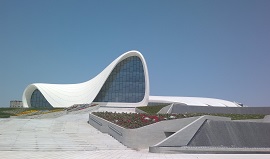Zaha Hadid
Dame Zaha Hadid was an architect known for her high-concept neo-futurist designs that gave her the label 'queen of the curve'. Born in Baghdad in 1950, she became the first woman in her own right to receive the prestigious Pritzker Architecture Prize in 2004, and the RIBA Gold Medal in 2015.
Initially studying mathematics in Beirut, Hadid moved to London in the early 1970s to attend the Architectural Assoication, where she later taught alongside the likes of Rem Koolhaas and Elia Zenghelis. London was to become the base for Zaha Hadid Architects which she founded in 1980. Throughout the 1980s she taught at the Harvard Graduate School of Design and a number of other international universities. During this period she began to be recognised for her innovative use of shapes, skewed perspectives and unusual geometric forms, notably in competition proposals for The Peak terminus in Hong Kong and the Cardiff Bay opera house that was later controversially cancelled.
It wasn't until 1993 that one of her designs was actually realised – the Vitra Fire Station in Germany, however, for all its ambition, it was criticised for its practical unsuitability by the firemen who occupied it. Towards the end of the 1990s, she designed the Mind Zone for the Millennium Dome and the first of the now-annual Serpentine Gallery Pavilion temporary structures.
Developing a reputation for seeking to push the boundaries of architecture and urban design, she experimented with the structural potential of concrete in the form of dramatic curves and angles on projects such as the Bergisel Ski Jump in Innsbruck (2002), and the Rosenthal Center for Contemporary Art in Cincinnati (2003). She also became involved in interior and product design, developing the Moon System Sofa for furniture manufacturer B&B Italia, and working with clothing brand Lacoste.
Perhaps her most famous building work is the Heydar Aliyev Cultural Center in Azerbaijan, with its sculptural skin bulging in smooth white waves. In 2010 and 2011 she won the Stirling Prize for the MAXXI museum in Rome and the Evelyn Grace Academy in London.
Despite many accolades, Hadid was no stranger to controversy, and often faced criticism for extravagant projects that spiraled over budget or were sponsored by states with questionable human rights records. Her design for the London Olympics Aquatic Centre suffered cost overruns, and her scheme for the Tokyo 2020 Olympics Stadium was cancelled due to escalating costs and local objections.
Sadly, Hadid passed away on 31 March 2016 when she was only 65 years old, with major projects ongoing such as the 2022 Qatar World Cup Stadium and a new airport terminal in Beijing.
Most notable buildings:
- Vitra Fire Station, Germany
- Bergisel Ski Jump, Innsbruck
- BMW Central Building, Germany
- MAXXI museum, Rome
- Riverside Museum, Glasgow
- Evelyn Grace Academy, London
- Heydar Aliyev Cultural Centre, Azerbaijan
- Messner Mountain Museum, Italy
- World Cup Stadium, Qatar
[edit] Related articles on Designing Buildings Wiki
- 600 Collins Street, Melbourne.
- Antoni Gaudi.
- Architect.
- Buckminster Fuller.
- Concept architectural design.
- D'Leedon, Singapore.
- Deconstructivism.
- Erno Goldfinger.
- Frank Gehry.
- Frei Otto.
- Masaryk Railway Station regeneration.
- Neo-futurism.
- Norman Foster.
- Parametricism.
- Port House, Antwerp.
- Richard Rogers.
- Salerno Maritime Terminal.
- Ted Happold.
- The architectural profession.
- The Architecture of Neoliberalism.
- UHAC, Saudi Arabia.
- Unusual building design of the week.
[edit] External references
- Zaha Hadid - Official site
Featured articles and news
Gregor Harvie argues that AI is state-sanctioned theft of IP.
Heat pumps, vehicle chargers and heating appliances must be sold with smart functionality.
Experimental AI housing target help for councils
Experimental AI could help councils meet housing targets by digitising records.
New-style degrees set for reformed ARB accreditation
Following the ARB Tomorrow's Architects competency outcomes for Architects.
BSRIA Occupant Wellbeing survey BOW
Occupant satisfaction and wellbeing tool inc. physical environment, indoor facilities, functionality and accessibility.
Preserving, waterproofing and decorating buildings.
Many resources for visitors aswell as new features for members.
Using technology to empower communities
The Community data platform; capturing the DNA of a place and fostering participation, for better design.
Heat pump and wind turbine sound calculations for PDRs
MCS publish updated sound calculation standards for permitted development installations.
Homes England creates largest housing-led site in the North
Successful, 34 hectare land acquisition with the residential allocation now completed.
Scottish apprenticeship training proposals
General support although better accountability and transparency is sought.
The history of building regulations
A story of belated action in response to crisis.
Moisture, fire safety and emerging trends in living walls
How wet is your wall?
Current policy explained and newly published consultation by the UK and Welsh Governments.
British architecture 1919–39. Book review.
Conservation of listed prefabs in Moseley.
Energy industry calls for urgent reform.



































